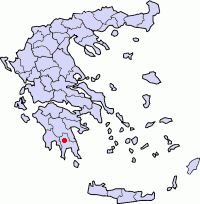Bronze Statuette of Athletic Spartan Girl

The Bronze Statuettes of Athletic Spartan Girl are bronze figurines depicting a Spartan young woman wearing a short tunic in a presumably running pose.These statuettes are considered Spartan manufacture dating from the 6th century B.C.,[1] and they were used as decorative attachments to ritual vessels as votive dedications, such as a cauldron,[2] suggested by the bronze rivet on their feet.[3] The figures typically have their hair hung down, right arm slightly bent, left hand lifted the hem of the chiton skirt and expose part of the left thigh, likely to facilitate the movement, and their legs in a wide stride.
The style the statuettes is attributed to Laconia (the region where Sparta is located) workshops in Archaic Period.The typical characteristics of Laconian bronzes are slender bodies with unproportional muscular legs, arched and swelling thighs, immature chest in female figures, and long faces with strongly marked facial features.[4] Laconia bronzes were widely traded, which helps to explain why some of those Laconia manufacture were not discovered in the region. It may also suggest the possible presence of Laconian craftsmen at that site.[4]
History
Female athletic costume in ancient Greece
The statuette in British Museum[3] is in a special kind of outfit: a short chiton affixed to the left shoulder leaving the right shoulder and breast bare. This is the type of athletic costume especially for the participant in Heraea Games,[4] the earliest recorded women running competition held quadrennially in Olympic stadium.[5] Although women in Ancient Greece (except Sparta) were not encouraged to participate in athletic activities and were excluded from the Olympic games,[6] they could participate in the foot race at Heraea, which is an athletic event for girls of all ages.[5] Thus, this particular piece depicts a participant in the Heraea. One speculation proposed that the costume is adapted from a light garment worn by men in hot weather or while performing hard labor.[7]
The piece from the National Archaeological Museum, Athens[8] is wearing a different kind of dress. Unlike the costume for Heraea Game, the bodice of the chiton covers both shoulders and breasts. It may suggest that this running costume is for girls at local ritual festivals in Sparta that are documented in ancient literature.[4] During the festival, some Spartan maidens ran a special race in honor of Dionysus.[1] This ritual celebrating the girls' rites of passage also involved dancing, singing and other athletic events.[9]

Athletic Spartan women
Women in Sparta led very different lives from their counterparts in the rest part of ancient Greece in terms of engagement in athletics. Spartan girls were offered a state-supervised educational system separated from the boys, including a physical training program.[2] The aim of the program was to produce healthy mothers of healthy warriors.[7] Spartan girls engaged in various athletic events including running and wrestling. They might even wrestle boys.[5]
Spartan girls were said to wear very little when they did sports. Wearing short tunics exposing half of their thighs, Spartan females were called "thigh flashers" according to some accounts in ancient Greece. There were complaints that they left home "with bare thighs and loosened tunics" on their way to run and wrestle. Serving as supplements to those ancient literary sources, roughly forty bronze statuettes dating from the Archaic period are found showing young Spartan women dancing or running (including the two discussed ahead). There are even pieces depicting Spartan female playing sports in nudity, just as the Spartan males.[2]
References
- 1 2 Dillon, M. "Did parthenoi attend the Olympic Games? Girls and women competing, spectating, and carrying out cult roles at Greek religious festivals". Hermes: 457–480.
- 1 2 3 Christesen, P. (2012-10-01). "Athletics and Social Order in Sparta in the Classical Period". Classical Antiquity. 31 (2): 193–255. doi:10.1525/ca.2012.31.2.193. ISSN 0278-6656.
- 1 2 "British Museum - figure".
- 1 2 3 4 Serwint, Nancy (1993). "The Female Athletic Costume at the Heraia and Prenuptial Initiation Rites". American Journal of Archaeology. 97 (3): 403–422. doi:10.2307/506363. JSTOR 506363.
- 1 2 3 D., Mills, Brett (1994). "Women of Ancient Greece: Participating in Sport?".
- ↑ Spears, Betty (1984). "A Perspective of the History of Women's Sport in Ancient Greece". Journal of Sport History. 11 (2): 32–47. doi:10.2307/43609020. JSTOR 43609020.
- 1 2 Scanlon, Thomas F. (1996). "Games for Girls". Archaeology. 49 (4): 32–33. doi:10.2307/41771026. JSTOR 41771026.
- ↑ "National Archaeological Museum of Athens – Official Site". www.namuseum.gr. Retrieved 2017-10-29.
- ↑ T., Neer, Richard (2012). Art & archaeology of the Greek world : a new history, c. 2500-c. 150 BCE. London: Thames & Hudson. ISBN 0500051666. OCLC 755071783.
Further reading
- Spears, B. (1984). A perspective of the history of women's sport in ancient Greece. Journal of Sport History, 11(2), 32-47.
- Dillon, M. (2000). Did parthenoi attend the Olympic Games? Girls and women competing, spectating, and carrying out cult roles at Greek religious festivals. Hermes, 457-480.
- Mills, B. D. (1994). Women of Ancient Greece: Participating in Sport?.
- Serwint, N. (1993). The Female Athletic Costume at the Heraia and Prenuptial Initiation Rites. American Journal of Archaeology,97(3), 403-422. doi:10.2307/506363
- Scanlon, T. (1996). Games for Girls. Archaeology, 49(4), 32-33. Retrieved from https://www.jstor.org/stable/41771026
- P. Christesen. (2012). Athletics and Social Order in Sparta in the Classical Period. Classical Antiquity, 31(2), 193-255. doi:10.1525/ca.2012.31.2.193